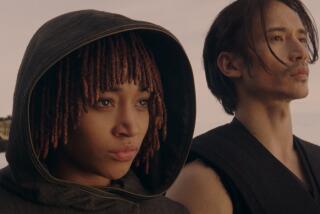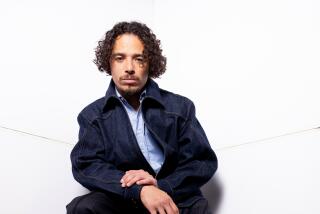From the Archives: ‘Star Wars’ hails the once and future space western
George Lucas has been conducting a lifelong double affair, embracing the comic strips on the one hand (or with one arm) and the movies on and with the other.
Now he has united his loves in “Star Wars,” the year’s most razzle-dazzling family movie, an exuberant and technically astonishing space adventure in which the galactic tomorrows of Flash Gordon are the setting for conflicts and events that carry the suspiciously but splendidly familiar ring of yesterday’s westerns, as well as yesterday’s Flash Gordon serials.
The sidekicks are salty squatty robots instead of leathery old cowpokes who scratch their whiskers and “Aw, shucks” a lot, and the gunfighters square off with laser swords instead of Colt revolvers. But it is all and gloriously one, the mythic and simple world of the good guys vs. the bad guys (identifiable without a scorecard or footnotes), the rustlers and the land grabbers, the old generation saving the young with a last heroic gesture which drives home the messages of courage and conviction.
There are inspirations (rather than borrowings) from the other movie forms, including the swashbuckler with its captive and endangered princess, the monster film with its creatures both good and evil, and almost any form with its second male lead wavering between cynicism and idealism but making the right choice in the very nick of time.
Tributes to the movie past have often been campy spoofs which suggest that it was all rather quaint. “Star Wars” is a celebration which, in the ultimate tribute to the past, has a robust and free-wheeling life of its own, needing no powers of recollection to be fully appreciated. It employs some of the dramatic devices out of the past for the good and simple reason that they worked well (and probably because they evoked strong and positive responses in the souls of those of us watching).
The magical mechanics of the movies seem to have been invented for simulating space travel, as Georges Melies saw before 1900 and as Stanley Kubrick demonstrated so spectacularly in “2001: A Space Odyssey” in 1968.
Lucas’ film cost significantly less than Kubrick’s even after inflation. But the small army of inspired technical effects creators he assembled have worked wizardries in some ways more lavish and varied than Kubrick’s own. (There are 70 individuals and five firms cited in the credits for the miniature and optical effects unit alone, in addition to the nearly four dozen creators listed in the main technical credits. The cast list conversely has to include bit parts to reach a scant two dozen.)
“Star Wars” is Buck Rogers with a doctoral degree but not a trace of neuroticism or cynicism, a slam-bang, rip-roaring gallop through a distantly future world full of exotic vocabularies, creatures and customs, existing cheek by cowl with the boy and girl next door and a couple of friendly leftovers from the planet of the apes and possibly one from Oz (a Tin Woodman robot who may have got a gold-plating as a graduation present).
After a once-upon-a-future-time-crawl establishing the story line–the brave rebels encamped on a secret star and darting out to do battle with the vastly larger imperial forces–Lucas plunges in the thick of things. His script takes it for granted that we know the lingo (we don’t but that’s the fun of it) and who’s who. We catch on quickly.
Mark Hamill is our likeable young hero, a sort of interstellar Jack Armstrong, rocketing around in the space-time equivalent of a Ford roadster and eager to try bigger stuff. He’s the orphan of a warrior who died bravely at the treasonable hand of a friend (David Prowse).
Events thrust Hamill into cahoots with his father’s old comrade in arms (Alec Guinness) and with the princess (Carrie Fisher) trying to get a desperately important secret message back to the rebels. It could undo the Imperials and their cruel leader (Peter Cushing).
Harrison Ford operates a tramp space freighter, no questions asked about cargo or passengers. Just the cocky sort to take our friends through hostile Indian country to the next settlement. (Through hostile space to the next star, that is; the old ways creep in.)
What all happens and how it all ends hardly matters. The narrative space is jet-propelled or rocket-thrust and the invention is continuous, the crafts and sets and space complexes genuinely amazing in their minute detailing and believability.
During production, Lucas said he was after a used future–a tomorrow that looked lived in and dented and tarnished. And, fittingly, one of the charms of the movie is that much of the gear does look as if it should be run through the nearest capsule wash or be had at with the chrome polish.
Some of the exteriors were shot amidst the lunar landscapes of Tunisia and Death Valley, so that the visual reminders of the dry gulch and box canyon West are inescapable. And there really are those rustlers, dealing in stolen robots and other hot goods.
If it is the larger-than-life fun which the movies have been and still are, Lucas provides majesty as well. John Williams has a score of unstinting dimension, soaring string sections and thundering basses and brilliant horns, which performed by the London Symphony Orchestra for the superlative sound system, lifts you out of your seat.
The finale borrows from the battle films at their most bravely hokey–the shrinking band of good guys fighting against ever-longer odds until there is only one chance left at saving the day.
The uses of the movie past extend to the calm after battle when heroes take their just salutes and we leave with the cheering thought that there may well be further adventures awaiting us all.
Lucas’ script and his film are a warm mixture of remarkable professionalism and an ingratiating innocence that is almost childlike (the squat robot is called ArtooDetoo, for R2D2).
Then again, many of us in our young days read Flash Gordon (envying Alec Raymond’s way with a drawing pen) and Buck Rogers, and believed with childlike faith (now seen to have been justified) that this was not yet the way things were, but would be. Lucas has taken us all back to the future and he has done it in a style both wonderfully ambitious and blessedly unpretentious. His characters speak neither in biblical cadences or an ornate Slavo-Oriental accent but in a wisecracking colloquial vein that derives equally from Cockney and Kansas City.
The awesome list of technical credits almost defies individual applause. But clearly production designer John Barry was a central shaping influence (he also did “A Clockwork Orange”). Cinematographer Gil Taylor, with a past as various as “Dr. Strangelove,” “A Hard Day’s Night” and “Frenzy.” mastered a whole new range of challenges. The special effects crucially involved John Stears (“Thunderball” and other Bond films) and John Dykstra, who worked on “Silent Running.”
The makeup men included Stuart Freeborn, who turned Albert Finney into Hercule Poirot, and Rick Baker, who was King Kong. A western barroom scene is populated with mutants and monsters that are a fantasist’s dream of Heaven.
It is, all in all, hard to think of a place or an age group that would not respond to the enthusiastic inventiveness with which Lucas has enshrined his early loves.
“Star Wars” (which proves again that there is no corporate substitute for the creative passion of the individual film-maker) opens Wednesday at Avco I Westwood and Anaheim City Center.
Back to the collection of reviews.
More to Read
Only good movies
Get the Indie Focus newsletter, Mark Olsen's weekly guide to the world of cinema.
You may occasionally receive promotional content from the Los Angeles Times.










